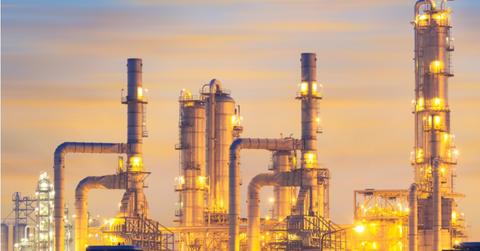Must-Know: The Top 10 Refineries in the US
US crude oil production has more than doubled since 2009 and grew by 1.1% over the last year. Currently, there are 133 operable refineries in the US.
Oct. 21 2019, Updated 7:57 p.m. ET

The United States had a total refining capacity of 18.8 million barrels per calendar day as of January 2019. Barrels per calendar day shows refining capacity in a 24-hour period accounting for planned and unplanned maintenance. The capacity grew by 1.1% over the last year. Significant growth in crude oil production added to the growth in refinery runs in the past decade. US crude oil production has more than doubled since 2009. Currently, there are 133 operable refineries in the US.
A refinery breaks down crude oil into its various components. This is done with three basic steps. The first step is distillation. This process separates the various crude oil components according to their boiling point. As a result, the heaviest fractions, such as gas oils, settle at the bottom. On the other hand, the lightest ones, such as gasoline, move to the top of the distillation unit.
The heavier hydrocarbon products are then ‘cracked’ into lighter ones, such as gasoline. This is done using heat, pressure, and catalysts. Finally, the products are treated to reach the desired quality and specification. Let’s take a look at the largest 10 refineries in the US.
Saudi Armco’s Port Arthur refinery
The above table lists the 10 largest refineries in the US. Saudi Armco’s Port Arthur refinery is the largest petroleum refinery. Commissioned in 1902, it is also one of the oldest. With a capacity of 607,000 barrels per calendar day, it has the highest capacity among all the refineries in the US.
In addition to conventional gasoline and diesel, it makes commercial aviation fuel and specialty products. Also, the unit has around 1500 employees.
Marathon Petroleum’s refineries
Marathon Petroleum (MPC) became the largest refiner in the US after the acquisition of Andeavor. It owns three of the 10 largest refineries in the US. Its Galveston Bay crude oil refinery is the second-largest in the US. The unit’s operating capacity grew to 585,000 barrels per calendar day in 2018. This happened when it merged operations with MPC’s Texas City refinery. It can make gasoline, distillates, fuel oil, dry gas, coke, propylene, and sulfur. Also, it has around 1,790 employees.
Apart from Galveston Bay, MPC’s Garyville and Carson refineries are in the top 10. Its Garyville refinery is the third-largest based on capacity. Garyville unit, which is in southeastern Louisiana, has a capacity of 564,000 barrels per calendar day. It has around 930 employees. Additionally, it can process crude oil into gasoline and distillates. Moreover, it can make coke, asphalt, propylene, propane, dry gas, slurry, and sulfur.
As the above table shows, Marathon Petroleum’s Carson refinery is the ninth-largest in the US as of January 2019. Also called the Los Angeles refinery, it has a capacity of 363,000 barrels per calendar day. It gets crude oil inputs from the Alaska North Slope, South America, West Africa, and other international sources. It makes reformulated CARB (California Air Resources Board) gasoline and CARB diesel fuel. Additionally, it makes conventional gasoline, distillates, coke, propylene, heavy fuel oil, and propane.
ExxonMobil’s refineries
With a capacity of 560,500 barrels per calendar day, ExxonMobil’s (XOM) Baytown refinery is the fourth largest in the US. Also, the refinery opened in 1920.
ExxonMobil’s Baton Rouge and Beaumont refineries are among the largest 10 refineries in the US. Established in 1909, the Baton Rouge plant currently has a capacity of 502,500 barrels per calendar day. In addition to gasoline and diesel, it makes jet fuel, aviation fuel, lubricating oils, and waxes.
ExxonMobil’s Beaumont refinery has a processing capacity of 369,024 barrels per calendar day. It makes 2.8 billion gallons of gasoline annually. Also, ExxonMobil is creating a new desulfurization unit at the Beaumont refinery. And, in January 2019, the company said it plans to expand the light crude refining capacity at Beaumont by 65%.
BP’s Whiting refinery
BP’s (BP) 130-year-old Whiting refinery has a processing capacity of 430,000 barrels per calendar day. Also, it makes around 10 million gallons of gasoline, 4 million gallons of diesel, and 2 million gallons of jet fuel every day. Additionally, it makes around 7% of the total asphalt production in the US. It is the sixth-largest refinery in the US.
Also, Whiting is creating a naphtha treating unit that will be operational in 2020. The unit will lower sulfur in the fuels made by the refinery.
PDV America’s Lake Charles
PDV Holding is the American branch of the Venezuelan state-owned oil company PDVSA. It is the parent company of CITGO Petroleum, which owns Lake Charles. Lake Charles is the seventh-largest refinery in the US.
The 75-year old Lake Charles plant can process 418,000 barrels per calendar day of crude oil. It has around 1,000 full-time employees. Also, the plant can make 8.8 million gallons of gasoline per day.
Chevron’s Pascagoula unit
Chevron’s (CVX) Pascagoula refinery is the 10-largest in the US. It can process 356,440 barrels of crude oil every day. Additionally, as an example, that amount is roughly equivalent to the size of a football field covered to a depth of 41 feet. It makes around 130,000 barrels per day of motor gasoline. Plus, it makes around 50,000 barrels of jet fuel and around 68,000 barrels of diesel per day.
Interestingly, with a capacity of 2.2 million barrels per day, Valero Energy (VLO) is the second-largest refiner in the US. However, none of its refineries are among the largest in the US. With a capacity of around 3 million barrels per day, Marathon Petroleum is the largest refiner in the US.
Also, read What You Need to Know about the World’s Largest Oil Companies to learn about the largest oil and gas companies in the world.
